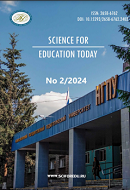Модель тандемного предметно-языкового интегрированного обучения: обоснование и оценка эффективности субъектами образовательного процесса
The model of tandem content and language integrated learning: Justification and evaluation of its effectiveness by education stakeholders
Author(s): Evgenia Alexandrovna Yurinova, Olga Gennadyevna Byrdina, Svetlana Gennadyevna DolzhenkoSubject(s): Education, Foreign languages learning, Communication studies, School education, Sociology of Education, Pedagogy
Published by: Новосибирский государственный педагогический университет
Keywords: Tandem training; Content and language integrated learning (CLIL); Education stakeholders; Dynamic groups; Foreign language professional communicative competence;
Summary/Abstract: Introduction. The need to master a foreign language in the professional field of education is determined by contemporary challenges: the rapid growth of intercultural interaction, as well as the processes of globalization and informatization of education. The article examines the problem of using tandem content and language integrated learning focused on developing future teachers’ readiness and ability to communicate effectively in a foreign language in the professional environment. The purpose of the article is to propose the model of tandem content and language integrated learning and evaluate the effectiveness of its implementation in the process of developing foreign language professional communicative competence of future teachers. Materials and Methods. The study was conducted during 2020–2023 period. The sample included 86 students of 3–5 years majoring in Primary education and English as a Foreign language. The authors used the following research methods: theoretical and methodological analysis, comparison, interpretation, modeling, questionnaires, analysis and systematization of accumulated experience of tandem content and language integrated learning. Results. The main results consist in substantiating the model of tandem content and language integrated learning and in assessing the effectiveness of its implementation in the process of developing foreign language professional communicative competence of future teachers. The authors identified a mechanism of interaction between all education stakeholders in dynamic groups based on task level-differentiation within the framework of content and language integrated learning (CLIL). Conclusions. The study concludes that the model of tandem content and language integrated learning was substantiated and the effectiveness of its implementation in the process of developing foreign language professional communicative competence of future teachers was assessed.
Journal: Science for Education Today
- Issue Year: 14/2024
- Issue No: 2
- Page Range: 78-99
- Page Count: 22
- Language: Russian

